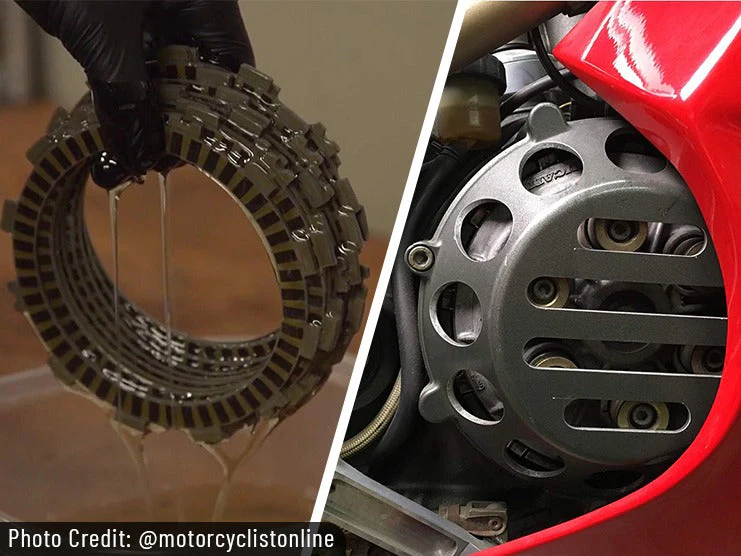A clutch is a simple device that transfers torque from the engine to the gearbox and then to the drive wheels. Clutches can come with single-plate, twin-plate, or multi-plate based on the number of driven discs.
Table of Content
The two main types of the clutch are the dry clutch and the wet clutch. A wet clutch has oil between the plates, while a dry clutch operates without oil. This article discusses the differences between dry and wet clutches.

1. What is a Dry Clutch?
A dry clutch is built to function without needing any lubrication, therefore there is less concern about it wearing out when exposed to air.
A dry clutch is inexpensive and reliable but often burns through more gasoline which can damage synchronization systems like the chains or crankshaft linkages since they have relatively high slip ratios.
The clutch plate on the dry clutch is located on the exterior next to the engine casing. Dry clutches offer greater torque transmission since they do not come with lubricants. Dry clutches usually come with a single plate. Compared to wet clutches, dry clutches make more noise; the noise the dry clutch makes grows louder the older and more degraded the dry clutch becomes. Dry clutches tend to suffer more wear and tear over time.
The dry clutch’s lid accumulates dust over time. Compared to a wet clutch, the dry clutch has a much shorter lifespan and requires more frequent maintenance.
2. What is a Wet Clutch?
A wet clutch is lubricated with engine oil to ensure smooth operation. Engine oil is poured over the wet clutch’s plates. A wet clutch has a small reserve of extra lubricant to better help heat dissipate during each rotation.
Although wet clutches last longer, they must be properly aligned to prevent overheating. Due to wet clutches being mechanical, they must be covered with oil-based lube, grease, or other protective layers to protect them from rusting.
The best time to accomplish this protection is while an engine is being constructed using copper slip or machine-applied sealants that are specially manufactured. A wet clutch system must still have a hardened surface for bushings and gears with high loads and failure modes that may materialize fast if exposed excessively. Oiling after installation will decrease wear, but it won't completely eliminate it.
Wet clutches include multiple plates and oil to cool and lubricate the parts. Wet clutches are used when applying high amounts of torque which cause a lot of friction. Compared to a dry clutch, the wet clutch makes less noise. The oil between the wet clutch's plates helps reduce scraping, therefore reducing excess noise. Compared to a dry clutch, a wet clutch has a longer lifespan. A wet clutch requires little maintenance and comes at an affordable price.
3.Functionality
3.1 How Does a Dry Clutch Function?
You press the dry clutch next to the pedal to release the gears. The pressure plate then retracts when the springs squeeze. Between the pressure plate and the flywheel, the clutch plate becomes loose.
As a result, the dry clutch can now disengage and change gears. This causes the flywheel to turn while the engine runs, with the speed of the dry clutch shaft gradually decreasing until it comes to a stop. The dry clutch is released when the clutch pedal is down; otherwise, the spring keeps the dry clutch engaged. The pressure plate returns to its original position once the clutch pedal is released, re-engaging the dry clutch again.
The dry clutch is engaged while the engine is running under normal circumstances. The dry clutch's coil springs and pressure plate compress and expand when a rider pulls the clutch lever to shift gears, allowing the dry clutch plates to move independently. The friction and steel plates swap places depending on how the dry clutch is being used. This causes the dry clutch and engine to operate at different rates. In the end, the dry clutch disconnects the transmission's power, allowing the rider to change gears.
3.2 How Does a Wet Clutch Function?
When operating a vehicle, a wet clutch has multiple drive plates arranged in the shape of a cage or a basket. Each drive plate has slots that fit into the clutch basket or cage via the notches at the ends of the plates. To engage the cage, the pressure plate assembly—which contains the drive plates and discs—slides into place. Since the clutch basket is connected to the drive train, this turns on the vehicle's drive train.
Even though the drive plate assembly is always connected to the engine, only parts of the plates are constantly rotating. The leverage from the friction plates is what gets the vehicle to start moving. Every disc begins to move together when the clutch is engaged.
The drive and friction plates are stacked on top of each other, held together by drive screws. These screws apply pressure to the plates but require oil to function properly.
4. Pros and Cons
4.1 Dry Clutch Pros
Transmission Efficiency
Dry clutches have greater overall transmission efficiency without any lubricant. The dry clutch’s drive shaft and clutch plate help minimize any loss of power.
Easy to Manage
Dry clutches have a simple design since they do not require lubrication and are built with a single plate. Due to their simple construction, they are easy to maintain and repair.
No Need for Additional Coolant
The dry clutch’s clutch plate is located on the exterior of the engine casing. This can easily be cooled without using any air coolant.
4.2 Dry Clutch Cons
Only Works on Low-Torque Vehicles
The dry clutch only works on vehicles with a low torque that does not exceed 250 lb-ft.
Wears Out Faster
The dry clutch tends to wear out faster due to its lack of lubrication. It tends to suffer more mechanical issues and requires maintenance more often.
Noisier
The friction caused by the dry clutch’s moving parts causes it to produce loud noises.
4.3 Wet Clutch Pros
Works on High-Torque Vehicles
The wet clutch is best suited for high-torque vehicles. The wet clutch’s multi-plate design allows them to produce more torque. Due to its larger surface area, the wet clutch causes more surface friction, which increases the amount of torque generated.
More Durable
The wet clutch is more durable due to its lubricated construction. Being lubricated allows the wet clutch to resist wear and tear even when under extreme strain. The engine oil shields the wet clutch’s metallic parts. The wet clutch does not need to be repaired as frequently and tends to last longer than dry clutches.
Less Noisy
The wet clutch is well lubricated to ensure it operates smoothly and quietly.
Removes Dust
Engine oil traps dust or other contaminants that are carried to the oil filter, keeping the system clean, effective, and efficient.
4.4 Wet Clutch Cons
Complex Construction
The wet clutch has a complex design made of multiple plates. Due to having more moving parts, there is more to maintain and repair.
More Power Loss
The wet clutch often suffers from power loss due to being covered in engine oil. The engine oil causes some of the generated torque to escape.
Fast Contamination
The additional engine oil on the wet clutch captures more dust and other contaminants, causing the oily surface to become dirty quickly.
5. Last Words
The dry and wet clutches share the same function of transmitting power but have features that make them different. The main difference is that the wet clutch has lubricant between the plates, while the dry clutch can function without lubricant. Moreover, the dry clutch has a single plate, produces more noise, wears out more quickly, and has better torque transmission power. Meanwhile, the wet clutch has a multi-plate design, produces less noise, takes longer to wear out, and has reduced torque transmission power. You can improve the appearance of your motorcycle by adding new saddlebags, fairings, handlebars, luggage racks, crash bars, and sissy bars.













Leave a comment
All comments are moderated before being published.
This site is protected by hCaptcha and the hCaptcha Privacy Policy and Terms of Service apply.